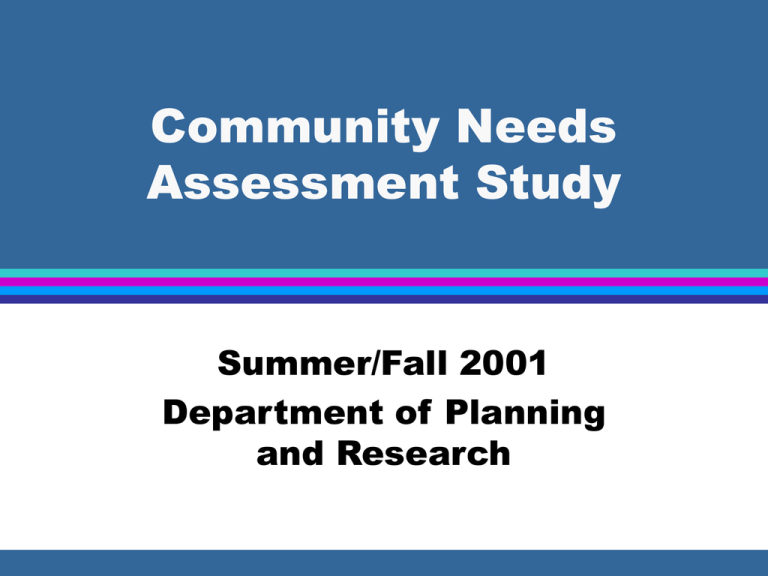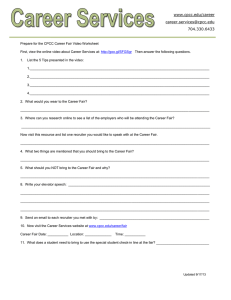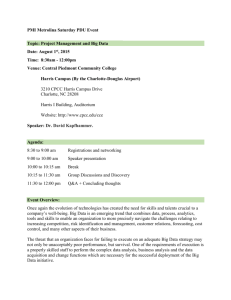Community Needs Assessment
advertisement

Community Needs Assessment Study Summer/Fall 2001 Department of Planning and Research Last Community Survey CPCC conducted the Citizen’s Survey in 1994 as part of the Strategic Master Plan This survey was conducted prior to the multi-campus expansion It was time to do another Procedures In the Summer of 2001 • An HTML survey was developed • Invitational ads were placed in newspapers, on the CPCC homepage and on the Fall 2001 schedule • 198 individuals/businesses completed on-line surveys Procedures The same survey was created as a scannable pencil-paper survey and approximately 350 copies were distributed by the campus Deans • They were distributed to civic groups, participants at community events and a few students in CCE classes • Several Deans participated heavily, others participated little or not at all • Surveys were returned by 179 individuals/businesses Procedures Planning and Research offered to do two focus groups per campus • To date, two were done at South, one was done at West and one was done with potential employers at the new Northeast Campus. • Additional focus groups are planned for West and Northeast Demographics of Respondents in 2001 (N=377) and 1994 (N=734) Gender • male • female Age • 25 or less • 26-40 • 41-50 • over 50 2001 35.9% 64.1% 1994 65% 35% 2001 19.1% 37.4% 25.1% 17.3% 1994 <.01% 49% 50% (<26) (25-44) (45>) Demographics, continued Ethnicity • White • African American • Other minority Employment Status • Unemployed • retired • Employed • full-time • part-time 2001 75.4% 17.7% 6.9% 2001 23.5% 76.4% 63.5% 12.9% 1994 88% 12% 1994 26% 20% 74% - Demographics, continued Income Level (question not asked in 1994) • • • • • 16.8% 27.8% 19.4% 21.4% 14.6% earned earned earned earned earned less than $20,000 $40,000 $60,000 $100,000 $19,999 annually $39,999 $59,999 $99,999 or more Demographics, continued Areas of Employment of Survey Participants • • • • • 20.4% business 8.8% education 8.8% technology 7.6% service 7.3% health • 27.4% other/not listed 6.7% 4.0% 4.0% 3.4% 1.5% banking/finance transportation engineering computer arts Relationship of Participants to College Participants could indicate more than one response. Participants by percent were: • 42.4% • 36.1% • 25.5% • 9.3% community residents /potential students current students former students employers Number of Potential Students by Household Participants were asked “how many in your household might be interested in attending the College?” • • • • 77.1% 15.6% 5.1% 2.2% indicated indicated indicated indicated 1-2 individuals “none” 3-4 individuals more than 4 individuals What Would Be Your Goal in Attending CPCC Participants could select more than one answer: 51.2% 35.3% 33.4% 33.4% 19.9% 19.4% 18.8% Personal interest/enrichment Take continuing education courses Prepare for different job Update skills for current job Obtain 2-yr degree and enter workforce Obtain diploma/certificate Obtain 2-yr degree and transfer Goal, continued 15.4% 15.1% 8.8% 6.1% 3.4% 1.6% Take a few courses and transfer Obtain short-term training (1 sem. or less) Improve reading, writing and math skills Obtain high school diploma or GED Prepare for first job Take ESL courses Participants could select more than one answer. Top Goals in Attending Based on Age Age Group Obtain degree & enter workforce Obtain degree & <26 26-40 41-50 >50 41.9% 18.2% 14.1% 6.3% transfer Take courses & transfer Prepare for diff. job Update skills Personal enrichment Take ConEd classes 45.9% 20.4% 7.6% 1.6% 39.2% 10.8% 17.6% 39.2% 18.9% 10.9% 36.5% 38.0% 49.6% 32.1% 6.5% 48.9% 41.3% 55.4% 44.6% 6.3% 31.7% 31.7% 66.7% 46.0% Campus Preference for Attending Classes Campus of Choice 2001 1994 • • • • • • • • • • 47.2% 32.4% 25.2% 23.1% 19.1% 18.8% 16.7% 10.1% 10.1% 5.6% 45% 36% Central South College Without Walls West Campus North Campus High School Location Southwest Northeast My workplace City View Center Participants could select more than one answer. 11% 52% Reason for Campus Selection Close to home Close to work Easy drive to and from Close to daycare or relatives Participants could select more than one answer. 78.0% 43.8% 45.6% 4.0% Reasons Based on Age Age Group Close to home Close to work Easy drive to and from Close to daycare or relatives <26 26-40 41-50 >50 79.7% 75.9% 41.9% 48.9% 66.2% 40.9% 81.5% 50.0% 35.9% 79.4% 25.4% 49.2% 2.7% 1.1% 7.3% 3.2% Convenient Time to Take Classes Compare • • • • evenings on weekends mornings afternoons 2001 1994 72.7% 40.8% 32.4% 22.8% 55% 28% 36% 17% Participants could select more than one answer. Time Based on Age Age Group Mornings Afternoons Evenings Weekends <26 26-40 41-50 >50 68.9% 47.3% 45.9% 27.0% 21.2% 12.4% 78.8% 48.2% 13.0% 13.0% 92.4% 37.5% 41.3% 31.7% 65.1% 36.5% Time Based on Employment Status Mornings Afternoons Evenings Weekends Employed Employed Unemployed part-time full-time 54.1% 41.2% 51.8% 29.4% 72.3% 38.3% 44.7% 19.1% 15.2% 13.0% 87.85 50.9% Are any of the following critical to the decision to attend? The following % answered “yes” 46.8% 37.1% 35.9% Tuition waivers Federal financial aid Scholarships Participants could select more than one answer. Critical issues in making the decision to attend - based on age Age Group <26 26-40 41-50 >50 Percent answering “yes” Scholarships 48.4% 45.9% 29.7% 6.7% Tuition Waivers 50.9% 53.9% 43.8% 34.5% Federal Financial Aid Program 42.4% 47.8% 37.5% 6.4% Critical issues in making the decision to attend - based on income level Income Level <20K 20-39K 40-59K 60-99K >99K Percent answering “yes” Scholarships 57.1% 44.7% 46.0% 24.6% 7.1% Tuition Waivers 66.0% 51.9% 58.2% 35.5% 20.9% Federal Financial Aid Programs 59.1% 48.1% 42.0% 20.6% 9.3% Greatest Barriers to Attending... Available personal time Work Schedule Financial Resources Time commitment Childcare My age Understanding registration process My formal education Transportation My disability Difficulty reading the schedule Participants could select more than one answer. 49.3% 46.9% 30.2% 18.0% 10.3% 5.8% 5.0% 5.0% 4.5% 1.3% .8% Top Barriers by Age Age Group Work Schedule Available Time Financial Resources Time Commitment Transportation Childcare <26 26-40 41-50 >50 41.9% 36.5% 51.8% 55.5% 60.9% 62.0% 28.6% 34.9% 28.4% 40.1% 28.3% 15.9% 16.2% 12.2% 8.1% 16.8% 1.5% 18.2% 20.7% 5.4% 6.5% 20.6% 1.6% 1.6% Top Barriers by Employment Status Unemployed Work Schedule Available Time Financial Resources Time Commitment Childcare 18.8% 28.2% 27.1% 7.1% 10.6% Employed part-time Employed full-time 44.7% 40.4% 31.9% 12.8% 10.6% 60.4% 59.6% 30.9% 23.9% 10.4% Top Barriers by Income Level Income Level Available Time Work Schedule Financial Resources Time Commitment <20K 20-39K 40-59K 60-99K >99K 32.1% 47.3% 37.5% 50.5% 52.3% 50.8% 63.9% 50.0% 51.0% 46.9% 44.6% 39.8% 40.0% 20.8% 4.1% 8.9% 18.5% 19.4% 20.4% 18.3% Services Considered Important in Making the Decision to Attend 94.6% 87.9% 87.7% 75.1% 70.5% 61.6% 60.0% 50.3% 48.8% 36.0% 29.0% parking library bookstore academic advising career services and job placement financial aid tutoring services food services lifetime email address student activities and campus life bus transportation Participants could select more than one answer. Top Services Considered Important by Age Group Age Group Academic Advising Career Services Tutoring Student Activities Library Bookstore Food Services Financial Aid Parking Transportation Lifetime Email <26 83.3% 74.0% 75.3% 66.2% 90.5% 94.6% 74.3% 64.9% 94.6% 41.9% 56.2% 26-40 70.7% 70.7% 64.2% 38.5% 86.7% 86.6% 47.8% 72.1% 92.6% 31.3% 45.9% 41-50 74.4% 68.5% 52.8% 19.8% 90.8% 87.8% 41.1% 63.2% 95.5% 23.0% 46.1% >50 6.0% 52.5% 46.6% 18.3% 85.2% 83.9% 43.5% 35.5% 98.4% 18.0% 53.2% Top Services Considered Important by Employment Status Unemployed Academic Advising Career Services Tutoring Student Activities Library Bookstore Food Services Financial Aid Parking Transportation Lifetime Email 83.5% 79.3% 63.7% 38.3% 92.4% 92.7% 51.2% 67.1% 91.6% 32.9% 50.6% Employed part-time Employed full-time 78.7% 78.3% 72.7% 60.9% 89.1% 88.9% 70.2% 68.1% 95.7% 44.7% 50.0% 72.7% 66.8% 58.2% 29.8% 86.8% 86.4% 46.5% 60.2% 95.6% 24.8% 48.7% Top Services Considered Important by Income Level Income Level Academic Advising Career Services Tutoring Student Activities Library Bookstore Food Services Financial Aid Parking Transportation Lifetime Email <20K 20-39K 40-59K 60-99K 89.1% 89.1% 77.4% 56.4% 98.2% 94.5% 66.1% 80.4% 94.6% 50% 63% 85.6% 81.3% 70.0% 42.2% 91.2% 93.4% 52.2% 80.4% 92.4% 33.0% 56.5% 80.0% 72.3% 69.8% 30.8% 92.3% 84.4% 55.4% 76.6% 98.4% 28.1% 53.8% 66.2% 63.9% 47.1% 31.9% 81.9% 86.1% 40.3% 36.6% 94.4% 19.7% 43.1% >99K 52.1% 40.8% 34.7% 12.2% 81.2% 79.2% 39.6% 25.0% 93.7% 14.6% 33.3% Preferred Time and Method of Using These Services Method • 61.5% • 34.6% • 3.8% via Internet/web page in person via mail Time • 63% • 26.6% • 10.4% evening daytime weekends The Best Way to Receive Information about CPCC 54.6% 42.2% 34.5% 29.4% 17.0% 9.3% 5.8% 3.2% CPCC catalog/schedule newspaper Internet word-of-mouth television or cable channel radio workplace or company newsletter billboards Participants could select more than one answer. Aspects of our Mission: What They Didn’t Know College offers pre-college programs (ESL, basic skills, adult HS, etc.) College offers college transfer programs College has supportive student environment College contributes to economy of community College strengthens social life of community College offers technical career programs Quality of faculty College has available students services College meets individual student needs Percent responding “I don’t kno 43.8% 42.6% 40.7% 37.8% 37.0% 36.3% 32.3% 28.3% 26.7% What They Didn’t Know, continued Percent responding “I don’t know” College contributes to cultural life of community Provides high quality programs and services College has variety of methods (in-class, distance ed., etc.) College is financially affordable Variety of class times Commitment to lifelong learning College offers a variety of programs College has convenient locations, accessible to work and home 26.5% 19.7% 18.3% 13.6% 11.8% 11.5% 8.6% 4.4% Aspects of Our Mission Mean Scores (How We’re Doing) Commitment to lifelong learning College offers a variety of programs College has convenient locations, accessible to work and home College offers technical career programs College has variety of methods (in-class, distance education, etc.) College is financially affordable College offers pre-college programs (ESL, basic skills, adult HS, etc.) Provides high quality programs and services Scale 1-4 -poor, fair, good, excellent Mean Score 3.23 3.17 3.14 3.12 3.10 3.07 3.06 3.05 How We’re Doing, continued Mean Score College offers college transfer programs Quality of faculty College contributes to economy of community College meets individual student needs Variety of class times College has available students services College contributes to cultural life of community College strengthens social life of community College has supportive student environment Scale 1-4 - poor, fair, good, excellent 3.00 3.00 2.94 2.90 2.89 2.86 2.85 2.83 2.80 Participants Were Asked…. “Were you aware that a student who completes their first two years of college coursework at CPCC and is accepted at any of the UNC four-year institutions, will enter as a junior and all course work will transfer?” 53.6% indicated that they were aware of our articulation agreement Participants Were Asked…. “Are you aware that high school students in CMS are allowed to earn college credit while attending CPCC during their junior and senior years?” 52.9% were aware of our collegeexperience programs Perceptions of CPCC Overall perception of CPCC • 79.4% positive or very positive • 9.5% neutral or no opinion • 3.3% poor Would you recommend CPCC to a friend or family member? • 99.2% said “yes” (82% without reservation and 17.2% with some reservation) What can CPCC do to attract students to the College? More marketing and visibility • • • • • • • • Advertisements Career fairs More information on internet Radio, cable TV or direct mail Free workshops Work with high schools Special programs in businesses Annual event highlighting opportunities …to attract students, continued More variety of courses • • • • more routes to get the GED more courses at area campuses and centers adult enrichment programs offer Information Technology courses like ECPI instead of Information Systems • more flexible scheduling (eve. and weekend) • more technical/vocational skills courses • specific courses (aviation, photography, writing, history) …to attract students, continued Student Services Issues • More financial aid services • Appeal to special interest groups • single-parents with older kids to encourage them to return to school • Older adults to overcome fears of learning • Reliable information on tutors and how to contact them What programs would you be interested in studying? 1. Technology Courses • • • • • • • • • Digital photography Computer applications Web design/development courses Desk top publishing Computer software IT certification in ConEd E-commerce Update your skills in Microsoft Programming …. Programs, continued 2. Culinary and Health • • • • hospitality education through CWW cooking and the use of herbs alternative medicine and medical terminology healthcare, respiratory care and nursing 3. Arts • • • • • Dance Yoga Art (for credit and non-credit) Music Creative writing ... Programs, continued 4. Office related • • • • • • • • • human resources starting your own business business administration purchasing certification marketing insurance public relations financial investing and financial counseling grant writing ... Programs, continued 5. Miscellaneous • • • • • • Spanish and other languages Aviation, professional pilots certification Auto mechanics, welding, pluming Child development Career services and career preparation Classes for fun (hobbies) As a community college, what does CPCC do well? Great access: place, courses and time Availability to those who wouldn’t otherwise have an opportunity Variety of programs Basics in all areas Prepares students to fill the need in the community Provides opportunities to people at different times in their lives, today’s career patterns, from Kid’s College to seniors Communicates with and touches the community Provides continuing education Reasonable price Serves the community For a Copy of this Presentation Go to: http://inside.cpcc.cc.nc.us/planning/default.htm click on “Studies and Reports”


